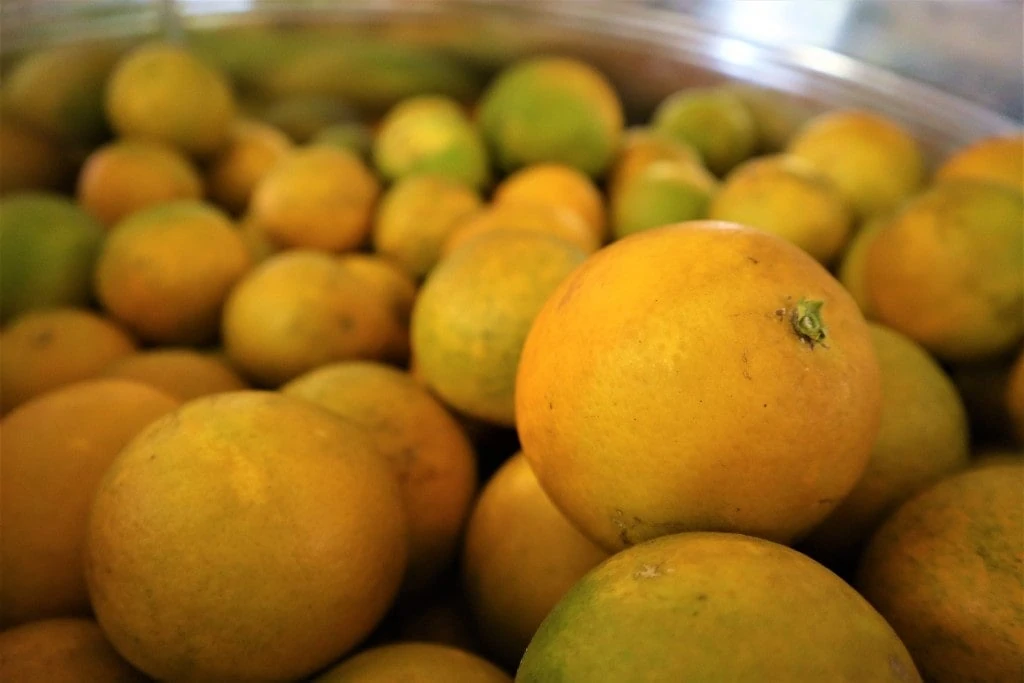by Amanda Rose Newton
If you were to ask someone what fruit comes to mind when they think Florida, chances are, it would be a type of citrus. Throughout the 1900s, the citrus industry was booming, and the result could be seen by sprawling orchards of beautiful trees producing oranges, grapefruits, and tangerines. Many beloved varieties, such as the tangelos, were developed right here in Florida.

Citrus we stock:
- Oranges: Navel, Valencia, Hamlin
- Tangerines: Dancy, Clementine, Murcott, Ponkan
- Hybrids: Honeybell and Sugarbelle Tangelos, Satsuma
- Limes: Key, Persian
- Lemons: Eureka, Variegated Pink, Ponderosa, Bearss, Meyer
- Grapefruit: Marsh White, Ruby Red
- Kumquat, Calamondin
- Dwarf Varieties
Because of Citrus Greening disease (HLB), it is proving extremely difficult to maintain healthy citrus trees for the novice and expert alike.
But if your heart is set on growing a citrus tree, don’t despair! It is still possible and armed with the information below, you can increase your chances for success.
Citrus Greening Disease
Before getting started, let’s talk about the biggest threat to citrus presently and why so many retail operations have had to close their doors in recent years.
Also known as Huanglongbing (HLB), this bacterial disease is spread by a tiny insect, called a citrus psyllid that feeds on the stems and leaves. With its piercing-sucking mouthparts, this little bug introduces a bacterium into the plant that impairs the ability of the tree to take in nourishment, resulting in reduced and increasingly undesirable fruit production. Fruit that is produced is increasingly smaller and tastes worse with each harvest. Once these bacteria are in the tree, there is no cure.
If you are serious about growing a citrus tree in Florida, knowing the signs and symptoms of Greening will help you manage your plant. While there is not a cure for Greening now, you can still maintain a consistently healthy fruiting tree with success if you are aware of the symptoms and preventative measures you need to take.
Learn more about citrus greening in our YouTube video here.
Symptoms:
- Leaves with irregular yellow splotching
- Crimped leaves
- Misshapen, bitter fruit
Think you may have greening? Feel free to send us a picture to info@rockledgegardens.com or bring in a sample to the info desk. Just make sure you bag it up!
Planting Your Tree
The first and most important step is making sure your plant is coming from a reputable source and is registered with the state. All trees, by law, must be treated with insecticide due to the various issues and diseases commonly plaguing the industry.
When selecting a variety, do your research! Certain fruits are better for juicing while others are better for eating.
Here at Rockledge gardens we LOVE to talk about the pros and cons of different varieties and can help you make the best selection. It’s your tree– make sure you get something you want!
The Perfect Spot
Citrus trees are most productive when grown in full sun. If you are going to plant more than one, make sure they are far enough apart and not too close to buildings.
Prepare your site by using 1-part Rockledge Gardens planting mix and 1-part existing soil to backfill the hole. Add 2 to 6 cups of Bio-Tone Starter Plus with the backfill, depending on the size of your plant. Then top dress with organic fertilizer, such as Espoma Citrus Tone fertilizer (amount to use is on the bag) and reapply every 3 months.
Watch our Proper Planting Installation video here
Be sure to follow our instructions for watering new plants. Also, be aware that citrus is only moderately salt-tolerant and will not tolerate salt spray at all!
If you live beachside, you might want to rethink your decision to plant or at least be very careful where you plant.
Pests and Disease
Your best defense is to be prepared! Following the recommended practices for planting, watering, and fertilizing keeps your plants healthy and makes them less inviting to pests.
Perhaps the next most important way to increase vigor and maintain the health of your citrus is by following our every-two-weeks regimen of spraying the foliage thoroughly with the following concoction, known as a “witches’ brew” by our resident citrus expert. It consists of three products:
- Captain Jack’s Dead Bug Brew for the bugs
- Citrus Grow Scripts Spray for health
- Genysis gets the products above inside the leaf and rainproof in 30 minutes
*Mixing ratio: 4 tbs Captain Jacks, 2 tbs Grow Scripts, and 1 tbs Genysis per gallon of water.
These three combined provide continuous protection against harmful pests like leafminers, or worse, the citrus psyllid, as well as provide an extra dose of quality nutrients biweekly.
To prevent fungal issues, spray with liquid copper fungicide 3 times a year (4 tsp per gallon) combined with 1 tbs of Genisys. Spray any time except when your tree is blooming.
Feeding Your Tree
First-year citrus love to eat and generally take readily to monthly fertilization with a non-organic product, such as Sunniland Citrus Fertilizer, or once every 3 months with organic Espoma Citrus-Tone (preferred).
Liquid seaweed, applied 4 times a year, helps boost the immune system of the tree and is especially good practice before the cooler months. Both the copper fungicide and the liquid seaweed can be sprayed as part of the “witch’s brew” described above.
Growing citrus can be successful, but preventative and ongoing steps are required to meet that goal.


